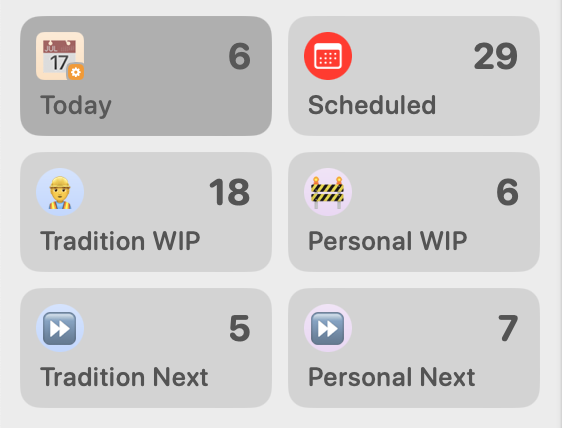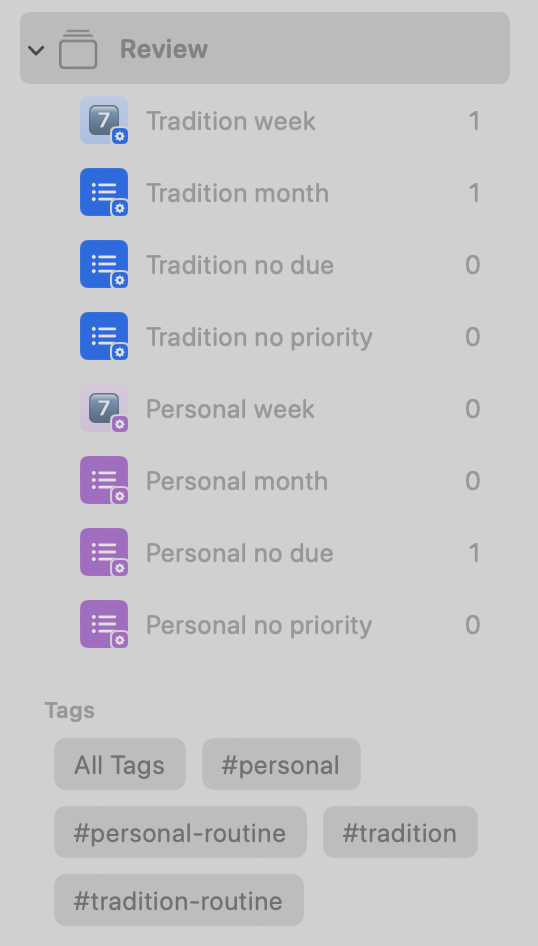Table of contents
Introduction
I used to think that merely using better or more sophisticated tools would magically make me more productive, blaming external factors and technology on my own lack of ability to achieve my dreams. But I’ve come to realize that it was only an escape into the procrastination playground to avoid facing hard work. Working on a system is not the same as working in a system. The former is a form of procrastination, while the latter is the actual work that needs to be done.
While there are great approaches including Zettelkasten and the Getting Things Done methodology, I have found that I work optimally with simpler systems that are easier to maintain, which reduce cognitive load and friction (less to think about and no complicated setup when inputting information either). I used to be an avid user of Todoist where I would implement GTD almost as a pure devotee, making the most of all its (relatively) advanced features, but that was a double-edged sword as dealing with timezone and synchronization issues was more than enough to derail me from the path, sometimes with dire repercussions when tasks would suddenly disappear or be scheduled at the wrong time.
Needless to say, I have since moved on to a simpler system that is more robust and that I can trust. I am not technologically turning back, but I have found Todoist’s weekly review process to be quite effective and easy to follow, so I have decided to adopt it as a basis for my own system, which I will be describing briefly in this post.
A whirlwind tour of the system
What follows is nothing revolutionary, but the simplicity of it just stuck with me. From prior research on the topic as I was building a todo application, it really stood out to me that the most effective systems were the simplest ones, especially when the different components can be neatly decoupled from each other while working well together as a whole. Arguably, the Apple ecosystem has done a great job at this — although I’m still enthusiastic about creating a single software destination to manage one’s life even more efficiently ;).
In reality, I just stuck with the default offerings for maximum compatibility and ease of use, but the truth is that the existing applications I have been in touch with do not fully address all my needs. As I’m not willing to try to bend reality to my will, I have decided to bend my will to reality for the time being and work with what I have. But I digress.

So the main idea here is very simple: twice a day, a daily review occurs and once a week, a more thorough weekly review is performed. Then, at the end of every month and every year, an even more thorough exploration happens both to reflect on the past and plan for the future.
Daily review

The purpose behind the daily review is twofold:
- To make sure that the day is planned out and that the most important tasks are completed.
- To do a mindful check on one’s wellbeing and re-adjust as needed.
Point 1. is self-explanatory. It serves as a good reminder that task estimation skills are not perfect and that one should not be too hard on oneself if things do not go as planned. Point 2. is a bit more subtle, but it is important to frequently take a step back and reflect on one’s current state of mind and body. That may include taking a break, going for a walk, or even taking a nap. The point is to be mindful of one’s current state and to take action to improve it if needed. In that department, I like to exercise early in the morning, both to expose my eyes to sunlight and to get my blood flowing (more on this in the excellent Huberman Lab podcast!). Besides sleeping well and eating healthy, I have found that this is the best way to ensure that I am in a good state of mind to tackle the day’s challenges.
Make relevant context accessible
One thing I like to do to stay on top of priorities is to “pin” a couple of active notes I’m using from Apple Notes directly inside the list of widgets shown when swiping left with two fingers on the touch pad (or clicking on the clock in the top-right corner). There, I quickly see notes like Working notes (to accompany the projects I’m currently working on), Standup so I can share updates with my team, @next_action which contains a list of stuff I plan to work on next without having to clutter my todo app and another one such as Ideas which I use as a scratchpad to empty my mind of any thoughts that might be distracting me from the task at hand or that might be useful later on.

Another major component of the way I organize tasks (currently with Apple Reminders) is to rely on smart lists and split them by areas of responsibilities. So while I may create tasks under specific lists, I tend to simply schedule everything that’s either recurring or that will need attention in the near future, storing the remaining ideas and potential tasks in Apple Notes.

So in this case, everything being scheduled for today or that has been flagged manually will appear in the Today list. Anything else that has a deadline in the near future will appear in the Scheduled list. Then, I simply divide my set of work in progress (WIP) tasks into work and personal and will drag and drop tasks from other lists/projects as needed to re-prioritize them. To avoid having a large list of items in the WIP lists, I use two separate lists to keep track of the Next actions: these are tasks that do not require immediate attention but used to be scheduled as being more urgent, since priorities will often need to shift under a set of constantly new circumstances.
These tasks will be dragged out of other lists as needed — either from the backlog of tasks or from the WIP tasks to declutter other lists. They will be prioritized as the Next actions to ensure that once the WIP is done, there is a continuity to the system. Just as with other lists, order matters, so that the most important tasks are at the top and the least important ones are at the bottom. This is a simple way to ensure that the most important tasks are always visible and that the least important ones are not forgotten.
Weekly review
The weekly review is a bit more involved, but it is still quite simple. The main idea is to take a step back and reflect on the past week, while planning for the next one. This is where I like to take a look at my calendar and make sure that I have not forgotten anything important. Given the current set of tools I use, I don’t really implement timeboxing as I find that I just tend to miss stuff I put into the calendar if it’s not an “all-day” event. Brace yourself, here it goes.

This probably looks more intimidating than it really is. I usually go through the whole process in under an hour. That may sound like a lot, but it really helps to declutter my mind while giving me the assurance I did my best to plan for the upcoming week. I also like to do this on Sunday mornings, so that I can start the week with clear focus. All in all, I find that this is a great investment and it becomes especially true if I adhere to doing it in the mornings right after I have a delicious cup of freshly ground coffee (but at least 90 to 120 minutes after waking up: again, see Huberman to get fantastic explanations on why this is ideal).
Automatic reviews
Once more, nothing too fancy is happening here, but having smart lists makes it very easy to review what is coming up. In this case, it’s mostly empty as it excludes all the work in progress, which makes it more useful as well since these are already accessible from their own lists, so the review section really highlights anything that is salient and non-recurring.

Monthly and yearly reviews
I can see the benefit in asking more questions and taking more time to plan ahead up to a point, but life is totally unpredictable and I find that it is not worth spending too much time planning for the future. Ultimately, everything is ephemeral: interests, hobbies or even relationships come and go. So my current approach is simply to repeat the weekly process with an emphasis on the things I might have neglected a bit more, such as planning new projects, dissolving old ones that no longer require attention and making sure that I am still on track with my goals at a higher level.
These moments also form a great opportunity to look at finances and make sure that I am not spending too much money on things that do not bring me joy or that I do not need. They also serve as a reminder to take a step back and reflect on the bigger picture, taking a break to look at all the progress that has been made so far. This becomes easier when things are tracked down by writing, and so I maintain a private GitHub repository called life-trail in which I write down a summary of my weekly reviews, keep track of the most important lessons I have learned and main events that happened in my life. This is heavily inspired from having gone through the Self Authoring Program, which I highly recommend to anyone interested in bringing more meaning into their life.
While (I think) I’d love to know for sure where I spend every minute of the day, I tend to track my time with Toggl only when I’m at the computer or reading books on my pretty old Nook e-ink reader. It doesn’t paint the full picture, yet it is not cumbersome to use and provides the kinds of insights I am looking for while forcing me to be more mindful about the actions I take moment to moment.
Conclusion
I have tried many different methodologies to get more organized and, after getting no further than where I used to be, I have reached the following conclusion, which can be elegantly summed up with Nike’s tagline: Just Do It. While one might have lofty goals, it all means nothing if one does not take action towards attaining them. This is why I have decided to adopt a more systematic approach in all aspects of life. This is not to say that I will not be using any tools, but rather that I will be using them with a focus on pragmatism and manifesting actual results.
More resources and references
- Huberman Lab podcast - Andrew Huberman.
- ProductiviDo - GitHub.
- Self Authoring Program - Jordan Peterson.
- Solving the Procrastination Puzzle: A Concise Guide to Strategies for Change - Timothy A. Pychyl.
- The Weekly Review - Todoist.
- Timeboxing - MindTools.
- Toggl - Toggl Time tracking.
- Work Notes by Sam Matla - Sam Matla.